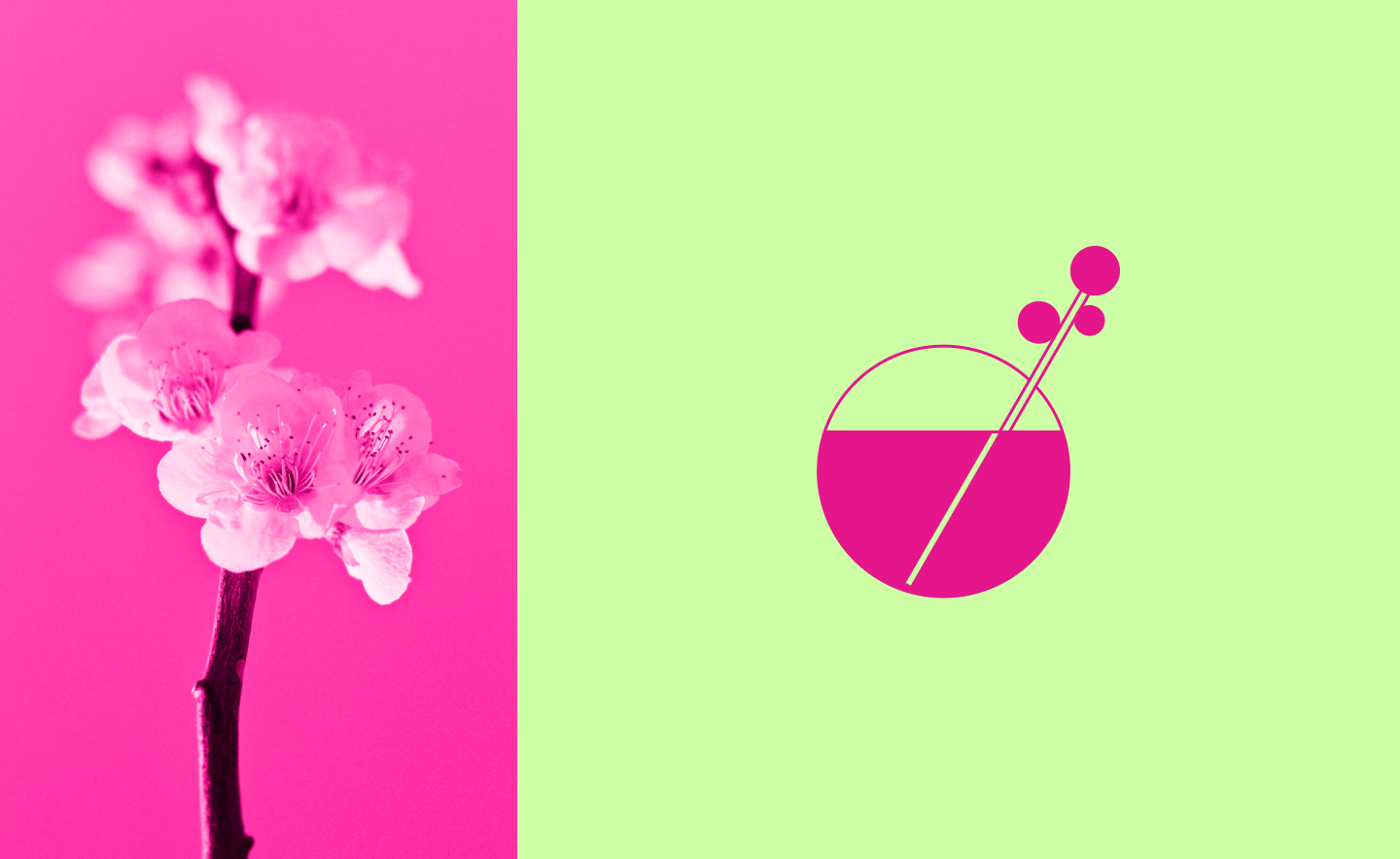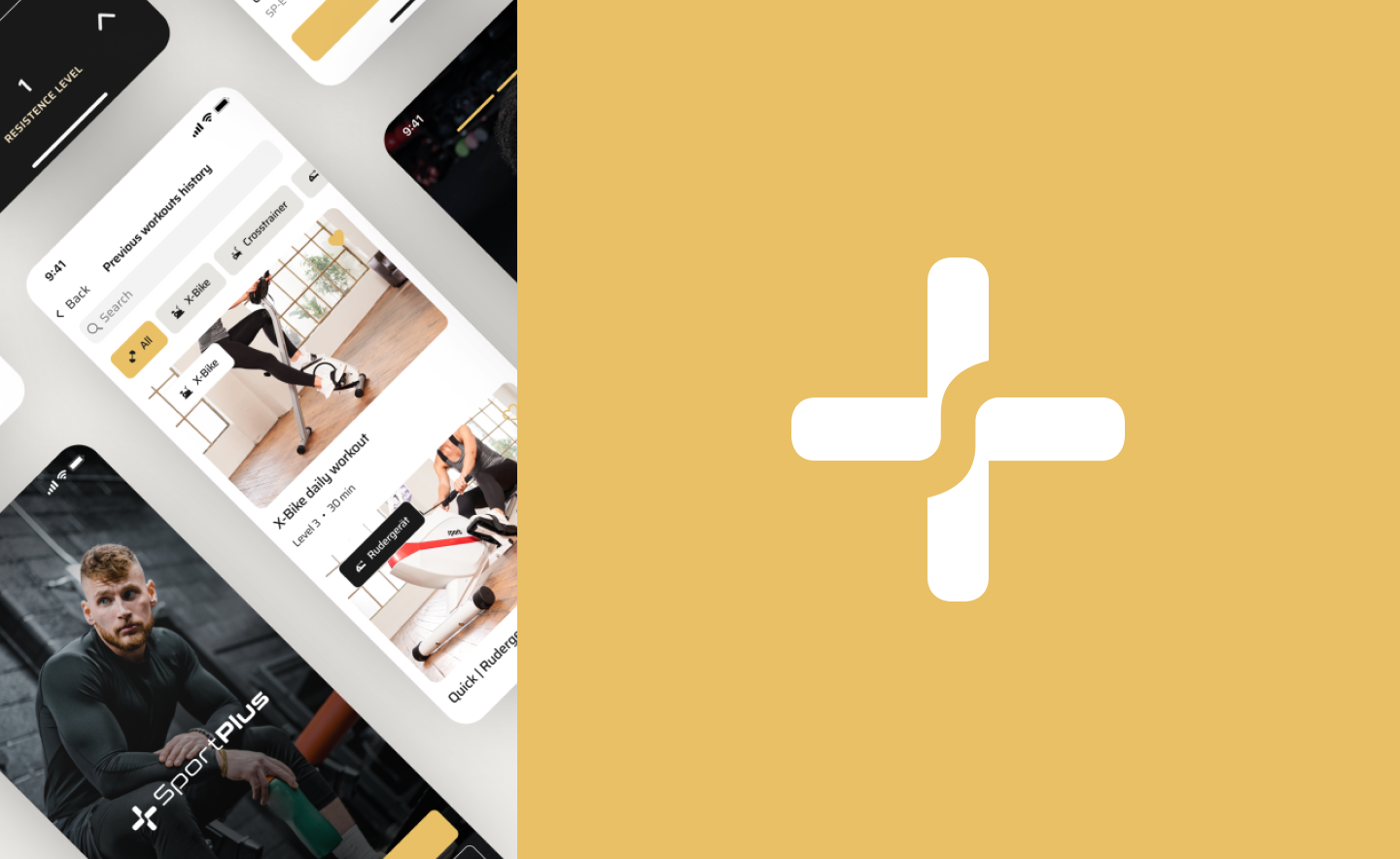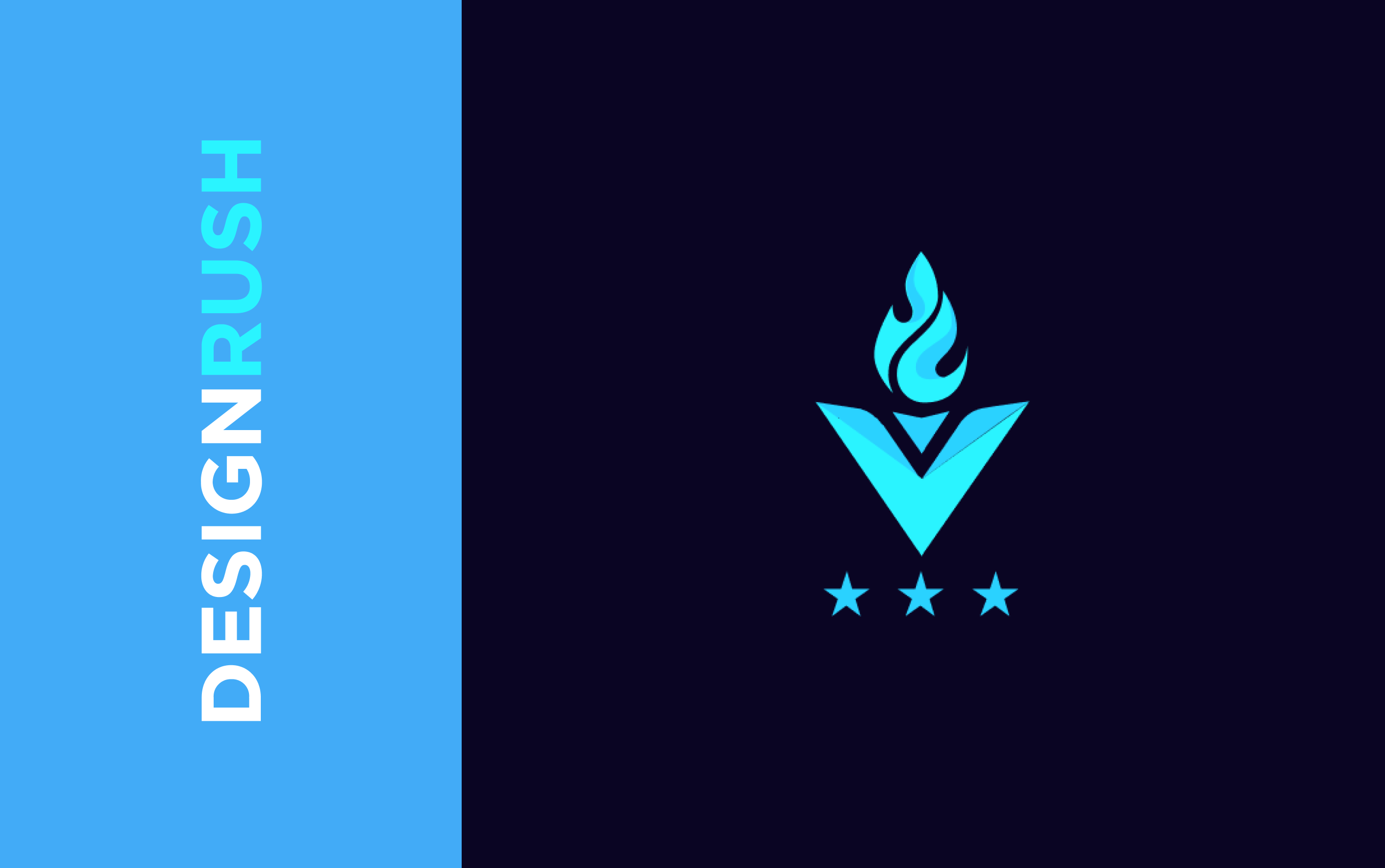It is not news that in today’s dynamically changing world, more and more people feel psychological pressure and cannot consistently maintain their mental state. We can even refer to statistics from WHO that says nearly 1 billion people live with a mental disorder; in low-income countries, more than 75% of people do not receive treatment.
Moreover, our world has been changed by the pandemic. The World Health Organization states that the COVID-19 pandemic has seriously affected mental health services in 93% of countries worldwide, while the demand for mental health has been increasing.
So, where to find help? Mental health app development is the answer. Such applications can help people maintain their condition or contact a psychologist virtually. The latter, by the way, is significant given that many people prefer shopping, socializing, or learning online. And going to a psychotherapist is no exception.
Get ready to explore the latest and most fabulous mental health app ideas! Our article delves into the trends, features, and design needed to make these apps truly effective. So, let’s dive in and discover how to take your mental health to the next level!
Mental Health App Development. What are these apps?
Developing mental health apps is a meaningful way to assist individuals in taking control of their mental well-being. These apps offer a broad spectrum of resources, ranging from educational materials to tools that allow people to easily track their mental health, including mood tracking, journaling, and goal setting.
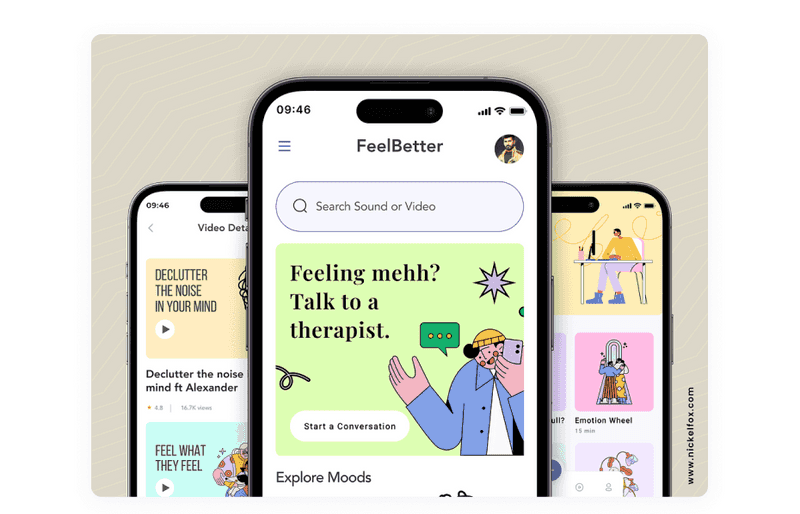
Dribbble shot by C Muthu Krishnan
A counselling app can also provide access to mental health professionals and resources, such as online therapy and support groups. Mental health apps can also provide reminders and tips for self-care and access to mental health resources and support. These apps can be used to help people better understand their mental health, as well as provide support and resources to help them manage it.
There are many benefits to mental health apps, including lower costs, more freedom of action, and a wider choice of therapists. Moreover, such apps are also highly secure. Mental health apps are usually designed with privacy and security features similar to those found in banks. In addition, some counseling apps are available, including Talkspace, BetterHelp, Regain, Teencounselling, and others.
Why Use Mobile Therapy App?
This is all very interesting, but does it work, and how effective is it? Why use mental health apps? Many therapists find mental health apps essential to psychotherapy because they help them develop a closer relationship with their patients and increase their ability to track their symptoms and mood.
There are studies on Mental Health Apps in Psychiatric Treatment conducted by professional doctors. They prove that using such applications helps people be more mindful, calm, and active. Keely Kolmes, PsyD, a clinical psychologist in San Francisco, said that many of her clients prefer apps to paper-based methods to record their thoughts and emotions.
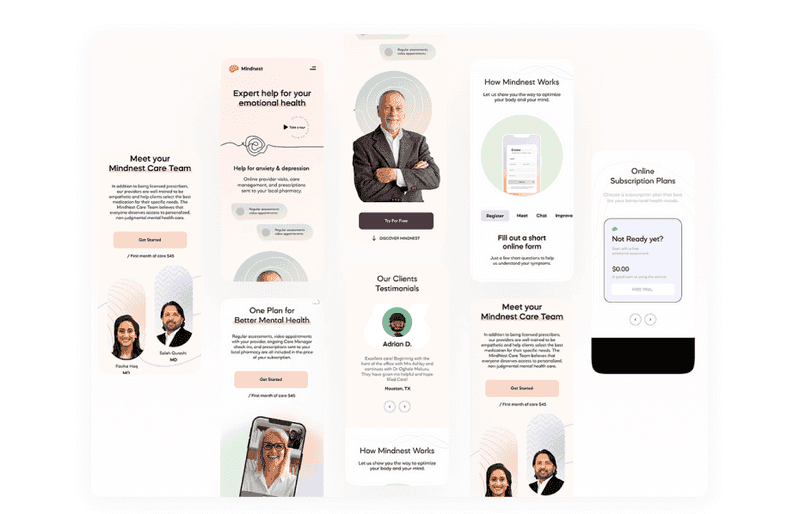
Dribbble shot by Bogdan Falin
«Therapy Apps prompt my clients to record stuff like their mood, whether they exercised, consumed alcohol, or slept well. So that I can provide an accurate image of their week, rather than them attempting to recreate things on paper the day before therapy or during therapy, which is far less reliable.»
In general, a mobile therapy app can be both part of therapy and a stand-alone tool for communicating with a psychotherapist or maintaining mental health through various exercises.
How Profitable is Therapist App Development for Business?
If you’re interested in therapist app development or mental health app development, you might be wondering how profitable it can be. Well, the good news is that there’s much potential here! With more and more people looking for mental health services, there’s a growing demand for mobile-based solutions like counselling apps. For example, according to a report by Grand View Research, the global online therapy market size was valued at $2.5 billion in 2019 and is expected to grow at a CAGR of 26.8% from 2020 to 2027.
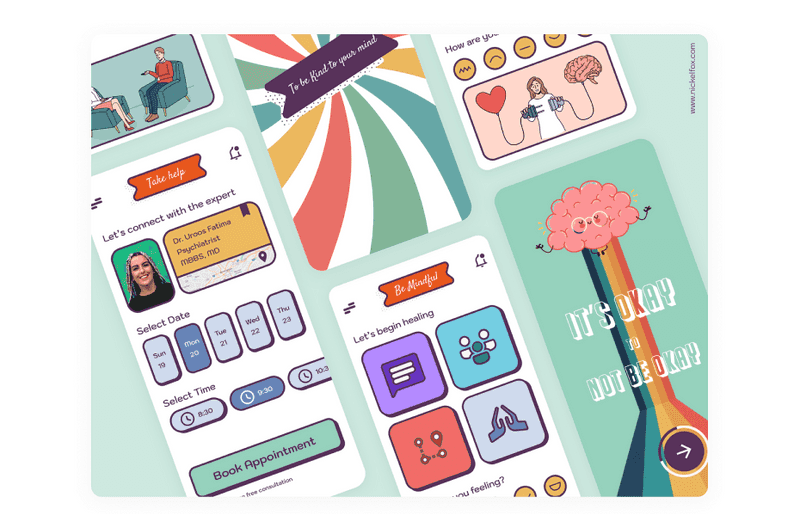
Dribbble shot by Nickelfox - UI/UX Design
Of course, creating a successful app takes work - you need to make sure you’re designing an app that users will actually want to use, and you’ll need to do some marketing to get the word out. But the profit potential can be significant if you create an app that meets users’ needs and gets some buzz going.
So if you’re interested in developing a mental health app, go for it! Just make sure you’re putting in the work to make it great, and remember to keep your users in mind every step of the way.
Steps to Create a Counseling App Like BetterHelp
If you want to create a counselling app like BetterHelp, you can learn a few things from their success. BetterHelp is popular because it offers users access to licensed therapists at an affordable price, and the app is user-friendly and easy to navigate.
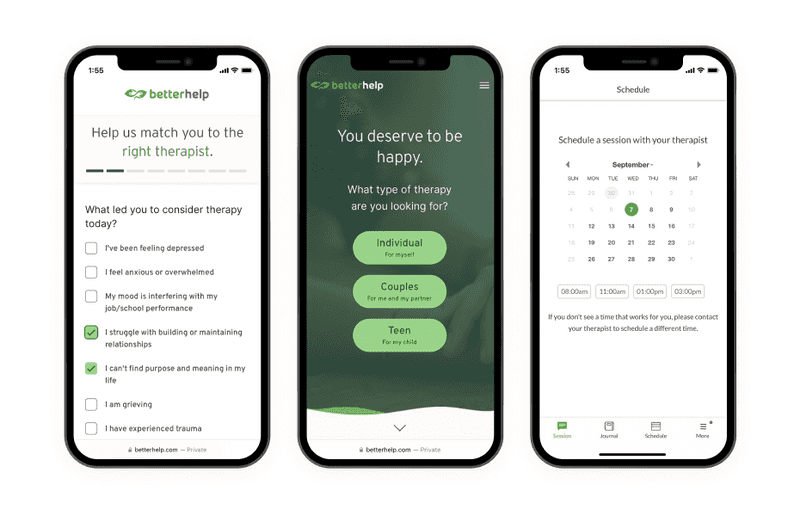
BetterHelp Product Screenshots
If you’re thinking about creating an app like BetterHelp, there are a few things you should keep in mind to make it successful. The most important thing is to ensure your app connects users with licensed therapists who can provide excellent counseling services. You should also consider pricing, as offering affordable options can help more people access the help they need.
Another critical factor to consider is user experience. BetterHelp is famous for its simple and easy-to-use interface, which makes it easy for anyone to find what they’re looking for. So, when you’re designing your app, make sure you pay attention to the design and usability to make it user-friendly.

BetterHelp Product Screenshots
Finally, don’t forget about marketing. BetterHelp has been successful in part because they’ve done a great job of marketing their app and getting the word out. Consider creating buzz around your counseling app and attracting users who might benefit from your services.
Next, we have compiled a list of points to consider when creating your application. Some have already been announced earlier, but we will explain everything in more detail here.
-
Conduct Market Research
The first step in designing a counseling app like BetterHelp is to conduct market research. Identify the gaps in the market and determine the needs and preferences of your target audience. Next, analyze the features of the BetterHelp app and see how you can improve or innovate them. Knowing your target audience and their needs can help you create an efficient and effective counseling app.
-
Choose a Business Model
You can choose from several business models when creating a counseling app. Some popular business models are subscription-based pay-per-session or a combination of both. Determine the best pricing and payment structure for your business and your target audience. Ensure your payment gateway is secure and reliable to protect your business and users.

Dribbble shot by Phenomenon Studio
-
Hire Qualified Counselors
The success of your counseling app largely depends on the quality of the counselors you hire. Ensure that the counselors you hire are licensed, qualified, and experienced. Provide them with adequate training and support to ensure that they deliver quality services to your users. Encourage your counselors to specialize in different mental health areas to cater to your users’ diverse needs.
-
Ensure Confidentiality and Privacy
Keeping user data confidential and private is really important in counseling. To make sure your app does this, it needs to have strong security measures in place. It’s also crucial to follow all relevant data privacy laws and regulations. And of course, users should always have the option to stay anonymous if they want to protect their privacy.
-
Decide on the core and additional features of your counseling app
When creating a counselling app, it’s essential to ensure you’re adding features that will help people. For example, offer self-guided exercises or personalized goal setting to help people get more out of their counseling sessions. And some people prefer video sessions with a licensed therapist over messaging, so offering that option is helpful too.
Adding the right features can also help your app attract more users and ensure you meet the needs of as many people as possible. Whether you’re working on a mobile therapy app or a mental health app, taking the time to think through your features and how they can help users is super important. So go ahead and get creative with it! -
Develop User-Friendly Interface
Creating a user-friendly interface is crucial for developing a counselling app. A good interface helps users navigate the app quickly, access the needed features, and get the most out of their counseling experience.
On the other hand, a poorly designed interface can be frustrating and confusing, which can ultimately turn users away from your app. So, when developing a mental health app or counselling app, it’s vital to prioritize user experience and ensure that your interface is intuitive, straightforward, and easy to use.

Dribbble shot by Alex Pesenka
So if you’re considering developing a mental health app, take a page from BetterHelp’s book! Focus on providing high-quality, affordable services, create a user-friendly interface, and think carefully about your marketing strategy. With some hard work and dedication, you can create an app that helps people get the mental health support they need.
And then, we will move on to a significant part of the application. These are the main features for users. They will attract new people to your application, so it is worth considering each feature in detail.
Core Customers Features
Core customer features for a counselling app include the ability to quickly and securely connect with a counselor, access various resources, such as articles, videos, and podcasts, and track progress and set goals.
Additionally, the app should provide a safe and secure platform for users to discuss their mental health concerns and receive support from a qualified counselor. It is just a brief overview. Let’s look at each point separately:
-
Social login
A new user can sign in using their social IDs by simply tapping the “Login with Facebook” or “Google” buttons or selecting any other platform.
-
Sign-Up procedure
To begin the sign-up procedure, you must choose a username, a password, and a working email address.
-
Surveys
After logging into the app, users will be asked questions about their health and condition to ensure they have enough information to match them with a therapist who best suits their needs.
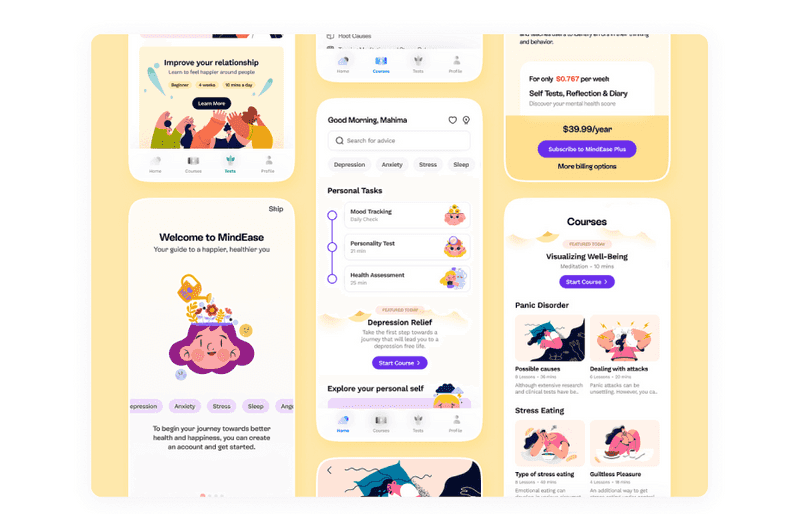
Dribbble shot by Mahima Mahajan
-
Manage profile
Users will have the option to edit their profile to reflect the information they choose to make public.
-
Dashboard
This feature provides users a comprehensive overview of their therapy progress and mental health status. It is a powerful tool that allows users to visualize their goals, track their progress, and monitor their mood over time.
The dashboard feature can display completed activities, upcoming tasks, medication reminders, and appointment schedules. Users can also view their mood history, including trends and patterns, and compare their progress against predefined goals.
It can also help users stay motivated, focused, and engaged in their therapy journey by providing real-time insights into their mental health progress. It is an essential feature for any mental health app and can significantly enhance the user experience.

Dribbble shot by Sulton Handaya
-
Choose a service
Customers can choose a service from which they want to receive advice, such as Anxiety, Addiction, Depression, Eating Disorders, and couples therapy for Financial problems, Parenting, and infidelity.
-
Goal setting
One of the critical features of a mental health app is the ability to set goals. Users can set goals for their mental health and well-being, such as reducing anxiety or increasing self-care. Goals can be tracked over time, and progress can be visualized, which can motivate users.
-
Progress tracking
Another essential feature of a mental health app is progress tracking. This allows users to see how they’re doing over time and make adjustments as needed. Progress tracking can also help therapists and counselors better understand their clients and provide personalized treatment.
-
Finding a therapist
When developing a successful mental health app, including this feature is crucial. First, it’s essential to create a user-friendly interface that allows individuals to search for licensed mental health professionals, compare pricing, and read reviews from other clients. Additionally, the app should include tools to help users evaluate a therapist’s qualifications, such as their area of expertise, education, and certifications.
By incorporating these into your therapist app development process, you can ensure that users can find a therapist who is a good fit for their unique needs and mental health concerns.
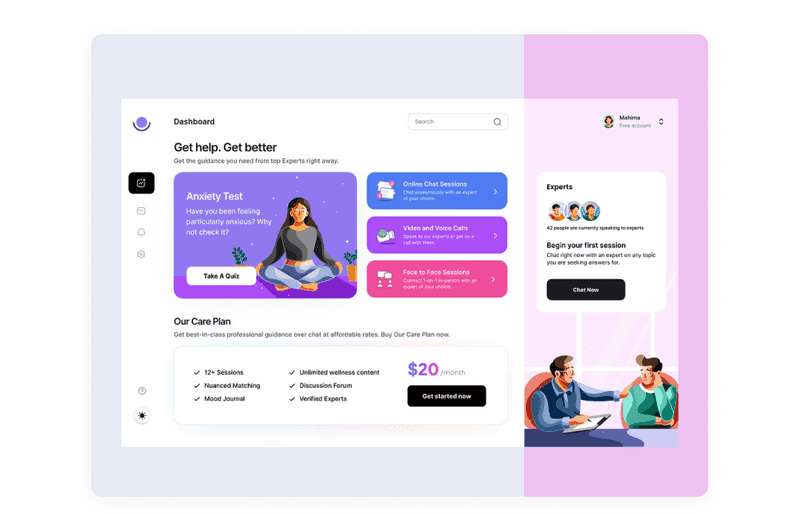
Dribbble shot by Mahima Mahajan
-
Chat and video sessions with a counselor
Due to the COVID-19 pandemic, telehealth services have become increasingly popular. In fact, at the pandemic’s peak, telehealth usage was 78 times higher than before, and it’s still 38 times higher today. This has made virtual visits the new normal for counselors. Therefore, if you’re developing a counselling app, it’s important to include features like chat and video meetings, so users can have therapy sessions without leaving the app.
You can also make the sessions more interactive by adding features like screen sharing, video recording, and document transferring. Doing so can improve the overall user experience and provide a more comprehensive counseling service. -
Sharing of files
A counselling app can allow users to share files with their therapist or counselor, such as journals or other written work. This can help therapists better understand their clients and provide more personalized treatment.
-
Online communities
Online communities are an excellent way for users to connect with others who are going through similar experiences. For example, a mental health app can include forums, chat rooms, or other online communities where users can share their stories and offer support to one another.
-
Articles on mental health
You can provide users access to online articles and resources related to mental health. This can include tips for managing anxiety, information on specific mental health conditions, and much more. By providing users with these resources, a mental health app can help them to understand their mental health better and find the support they need.
-
Emergency help
Sometimes, mental health issues can cause immediate problems that need immediate solutions. In these cases, it’s essential to have quick access to emergency help. That’s why a mental health app should include an emergency feature that allows patients to call for help or send a message to their counselor and caregivers with just one click.
For instance, patients can have a pre-saved list of emergency contacts, including 911 or your service’s 24/7 support. This feature can give patients a sense of security and comfort, knowing that help is always just a click away.
-
Notifications and reminders
It can be easy to forget to check in on your mental health, which is why notifications and reminders can be so helpful. For example, a mental health app can send reminders to users to check in on their mental health, take medication, or complete other activities related to their well-being.
In conclusion, choosing the right core features for a counselling app is crucial to its success. The core features, such as chat and video sessions with the counselor, goal setting, progress tracking, online communities, sharing of files, and online articles on mental health, provide the foundation for a practical therapy experience.
These features can help users and therapists connect more easily, monitor progress, and access relevant resources. But we don’t stop there. Next, we will tell you what other additional features may be present in the application for mental health.
Additional Customers Features in Therapist App Development
Adding these to your mental health app can increase user engagement and provide additional value to your users. By offering tools and resources that users can utilize to manage their mental health, you can help them feel supported and encouraged to continue using the app. Here are a few additional features to consider including in your counselling app:
-
Questionnaires
Incorporating questionnaires into your app can help users understand the severity of their symptoms and whether or not they need immediate counseling from a mental health professional.
-
Games and audio-visual tools
Providing users with games and audio-visual tools for relaxation and meditation can be a fun and effective way to help them manage stress and anxiety.
-
Mood tracking
Allowing users to track their moods over time can help them identify patterns and triggers for their mental health concerns.
-
Diaries or logbooks
Giving users the ability to record important events, such as medications, sleep, exercise, and social interactions, can help them identify potential areas for improvement and monitor progress.
By incorporating these additional features into your mental health app development process, you can create a more comprehensive and engaging user experience for your users, ultimately helping them to take control of their mental health and improve their overall well-being.
The Features of a Counselling App Essential for Pros
When it comes to mental health professionals and healthcare providers, having a web or mobile app to interact with patients is essential. Therefore, creating a mental health app for professional users is as important as creating one for patients.
There are two ways to develop an app for professionals: either as a separate solution with a back-end that connects to the patient app or as two versions of the app so users can choose their role when signing up. Here are some essential features that should be included in the app for professionals:
-
Sign-up and sign-in
Quick, secure, and preferably connected to a social account.
-
User profile
A detailed user profile includes name, photo, specialization, contact details, rating and reviews, pricing, available appointment hours, and other communication.
-
Scheduling tool
This feature can be integrated with a calendar for managing appointments and workload.
-
Patient profile
Access to an extended patient profile with a medical history, current diagnosis, prescriptions, lab results, documents, photos, and more.
-
Communication with patients
Ability to talk to patients via audio/video call or live chat and share files within conversations.
-
Analytics and dashboards
There, professionals collect information about patients to monitor their progress, generate reports, adjust therapy, and track metrics such as daily/weekly/monthly number of patients, revenue, and revenue per customer.
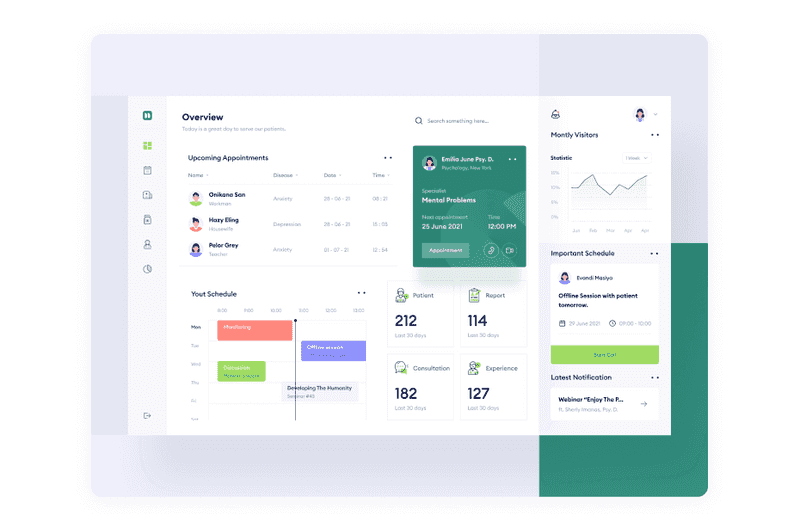
Dribbble shot by Riko Sapto Dimo
-
Content management system
A way for professionals to upload, update, and delete different content.
-
Electronic health records
Electronic health records (EHRs) are digital records of a client’s medical history, including their mental health history. This feature enables therapists and counselors to access a client’s EHR and review their treatment history, medications, and other critical information.
-
Payment processing
Payment processing allows therapists and counselors to accept client payments for therapy sessions. This feature can help streamline the payment process and reduce administrative burdens.
-
Referral network
A referral network feature enables therapists and counselors to refer clients to other mental health professionals when necessary. This feature ensures clients receive the care they need and can be an essential component of a comprehensive mental health app.
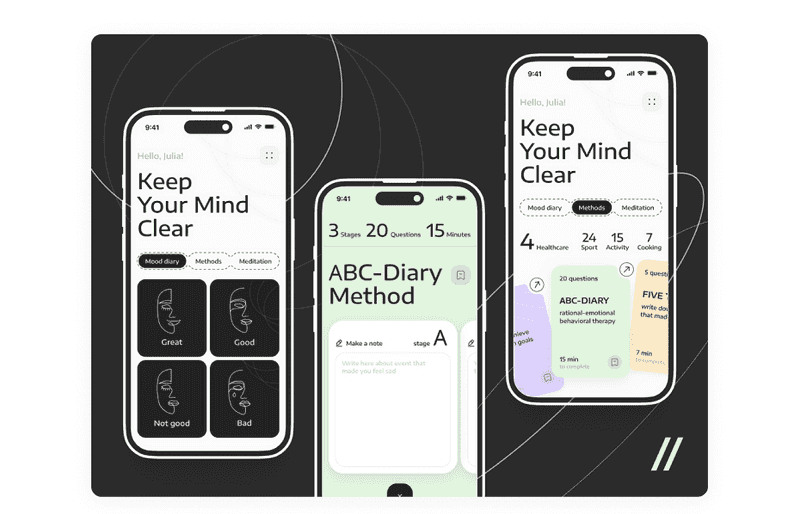
Dribbble shot by Purrweb UI/UX Agency
Once you’ve decided on the features you want to include in your counselling app, you’ll need to start designing. It is where you’ll need to get creative and think outside the box. You’ll need to ensure your app is secure and reliable and meets all the necessary regulations. You’ll also need to confirm your app is compatible with all the different devices and operating systems.
How to Develop a Mental Health App: Best Practices
Our previous article on the design process covered all the necessary steps to create any application. For now, we will look at some individual things or things that were not covered in the previous article.

How Do the Perfect Design Process Steps Look?
Create a Pretty Mental Health App Design
Creating a visually appealing and user-friendly UI design is crucial for the success of any mental health app. In addition, creating an engaging and intuitive design is essential when developing a counseling app while incorporating elements that reflect the app’s purpose.
One way to create a beautiful UI design for a mental health app is to use calming colors and imagery that promote relaxation and positivity. For instance, shades of blue and green can evoke feelings of tranquility and peace, while bright colors can elicit energy and motivation. By the way, color is generally an essential aspect of design. But did you know that colors can influence people? If this interests you, then go to our fantastic article about it.

Color Psychology: How to Choose Colors That Attract Customers?
Incorporating simple and easy-to-navigate menus and icons is vital in mental health app design. People using these apps should be able to find what they need quickly and without stress so they don’t get discouraged or frustrated. When an app is designed well, it can help users stay engaged and motivated to use it regularly.
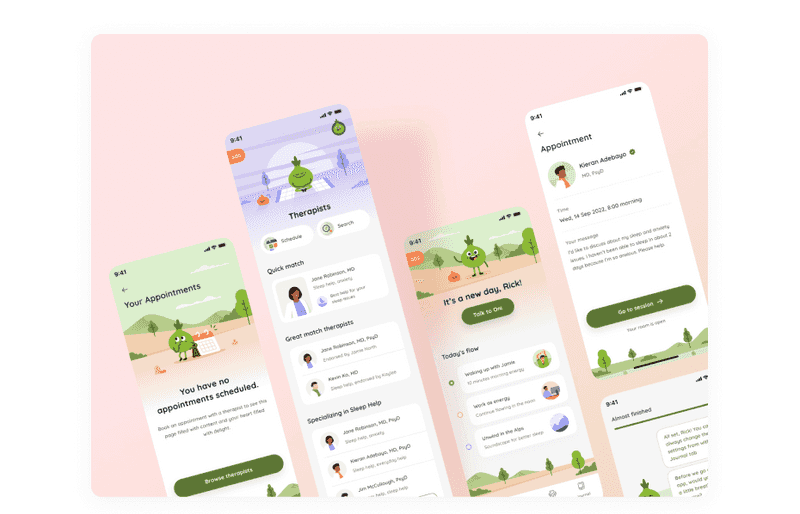
Dribbble shot by Riko Sapto Dimo
It’s super important to have really great images and graphics that fit with what your app is all about. Having pictures of nature or peaceful environments can be a big help in making people feel relaxed and less stressed out. Plus, having images that match what your app is all about can help users feel more connected and interested in what you’re doing.
When developing a mental health app, it’s essential to remember the needs and preferences of the app’s target audience. Design elements should reflect the unique needs of users seeking mental health resources, such as those dealing with anxiety, depression, or other mental health issues.
Overall, creating a beautiful and user-friendly UI design for a mental health app requires attention to detail and a deep understanding of the target audience’s needs. And if you want to learn more about selling and engaging UI design, check out our article. In it, we have analyzed all aspects of visual design.
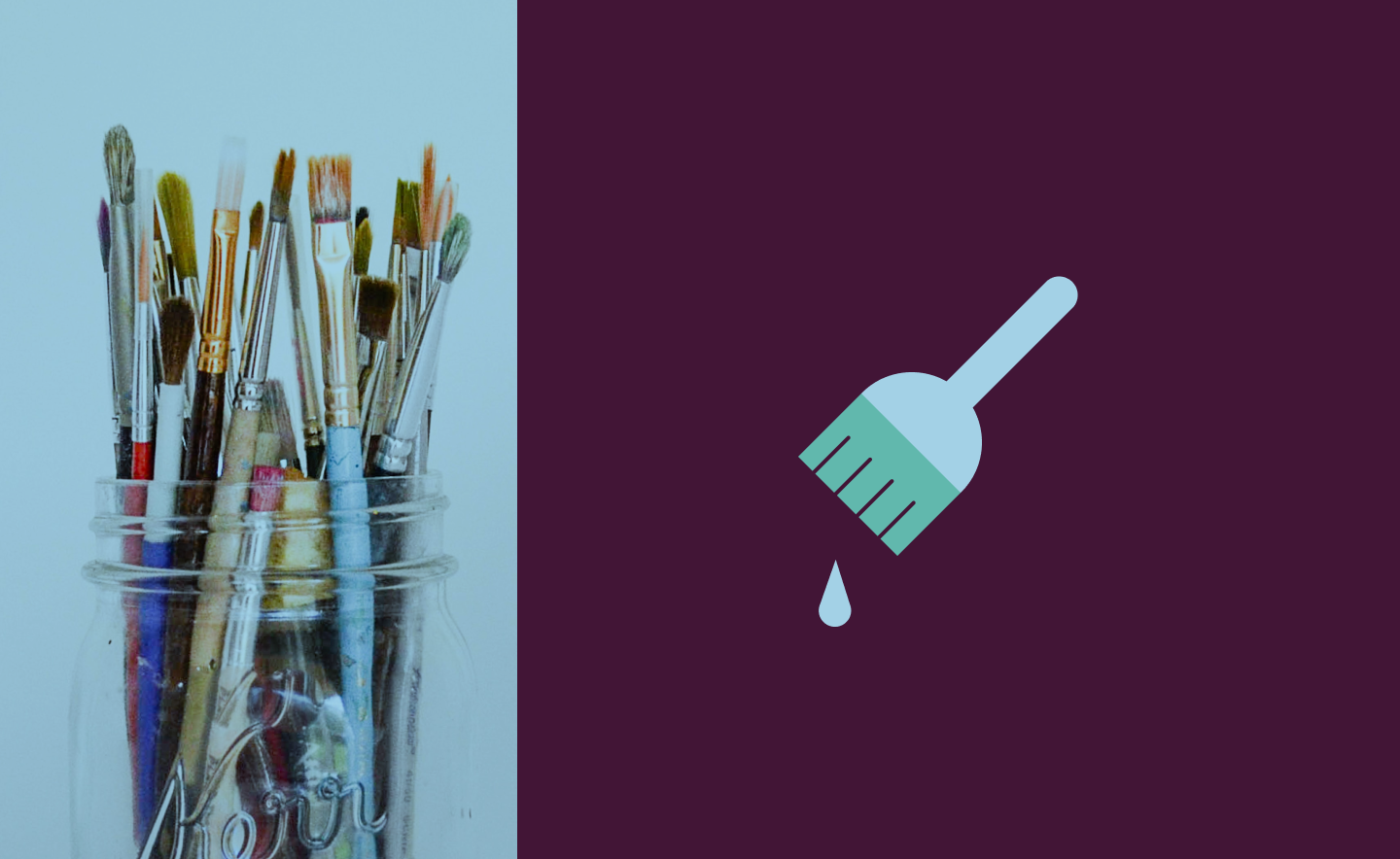
Take My Money: Make a Selling Visual Structure for a User Interface
Incorporate Motivational Triggers in Your Mental Health App Design
When developing a mental health app, incorporating motivational triggers can make all the difference in keeping patients engaged and committed to their therapy. To achieve this, consider implementing the following ideas in your mental health app design:
-
Positive Reinforcement
Develop a reward system that provides virtual badges, stars, or trophies to users who complete specific tasks or reach milestones. This can give users a sense of accomplishment and motivate them to continue using the counselling app.
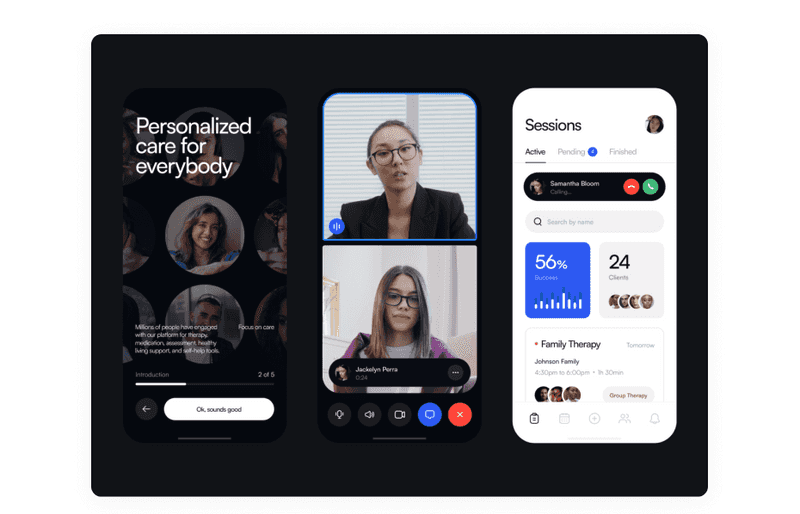
Dribbble shot by Dmitriy Groshev
-
Personalized Feedback
Provide feedback to users based on their progress. For example, send messages or notifications highlighting their achievements and areas where they have improved. This feedback can encourage users to continue making progress.
-
Gamification
Incorporate games and challenges into your mental health app. These can be simple puzzles or complex challenges that require critical thinking and problem-solving skills. Gamification can make the therapy more enjoyable and engaging for users.
- Inspirational Content
Include motivational quotes, daily affirmations, and inspiring stories in your mental health app. Display them on the home screen or in notifications to help users stay positive and motivated throughout their therapy.

Implementing these motivational triggers in your mental health app development can help keep users engaged, motivated, and committed to their therapy.
Don’t Forget About Marketing
Marketing is a crucial aspect of mental health app development. When creating your counselling app, it’s essential to consider your target audience and the best channels to reach them. Social media is an effective way to build awareness and promote your mental health app to a broader audience. Utilizing platforms like Facebook, Instagram, and Twitter can help you connect with potential users and build a community around your app.
But don’t stop there. Partner up with mental health clinics, hospitals, and professionals to get some street cred and reach a wider audience. Also, consider collaborating with mental health influencers and bloggers to help promote your mental health app.
In addition to these strategies, Don’t forget about SEO. You want your app to appear at the top of those search results, right? So, use relevant keywords in your counselling app description and optimize everything you can.
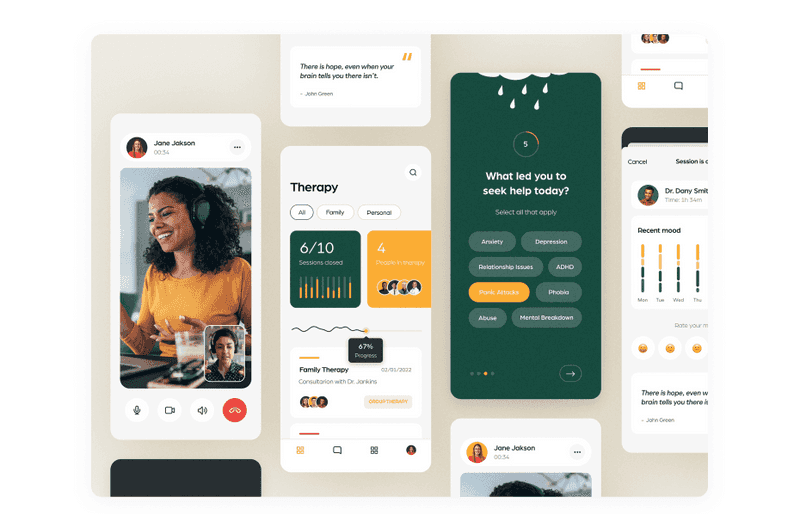
Dribbble shot by Arounda Mobile
Finally, offering free trials, promotions, and discounts can also effectively attract new users and encourage them to try out your counselling app. By providing value and a positive user experience, you can turn these users into loyal customers and advocates for your mental health app.
Monetization Strategy
Monetization is an essential aspect of developing a mental health app. There are several ways to generate revenue from a mobile therapy app while still providing value to users:
-
Freemium
One of the most popular strategies is to offer a freemium model, where users can download the app for free but have to pay for premium features such as personalized therapy sessions or access to advanced tools.
-
Subscription-based plans
Another strategy is offering subscription-based plans that give users access to various features and services. This model is suitable for those who require ongoing therapy and support.
-
Advertising
In-app advertising is another way to generate revenue. However, ensuring that the ads are relevant and non-intrusive to the user experience is crucial.
Prioritizing user needs and privacy is vital to success in the mental health app industry. By offering premium features, subscription-based plans, and relevant advertising, you can add value for users. But it’s essential always to stay ethical, transparent, and compliant with applicable laws and regulations.
Regulatory Compliance
Regulatory compliance is a critical aspect of developing and launching a mental health app. Mental health apps are subject to several regulations, including HIPAA (Health Insurance Portability and Accountability Act), GDPR (General Data Protection Regulation), and FDA (Food and Drug Administration) guidelines.
-
HIPAA
It regulates the privacy and security of personal health information (PHI), which includes any information that can identify a patient. Therefore, developers must ensure that their app complies with HIPAA regulations and that all patient data is encrypted and stored securely.
-
GDPR
This regulation protects the privacy of personal data of European Union citizens. Therefore, if an app is available in the European Union or collects data from EU citizens, it must comply with GDPR.
-
FDA
It regulates apps that are considered medical devices. If the mental health app is designed to diagnose, treat, or prevent a medical condition, it is subject to FDA regulations. Developers must obtain FDA clearance before launching the app.
In addition to these regulations, mental health apps must comply with state and federal laws governing telehealth and telemedicine. These laws vary by state and can be complex, so developers must seek legal advice to ensure compliance.

Dribbble shot by Mikha Makhoul
Overall, regulatory compliance is essential for the success of a mental health app. You need to be aware of the regulations and guidelines and ensure that your app complies with all applicable laws to protect patient privacy and ensure its safety and effectiveness.
Data Security
When developing a counselling app, it is crucial to prioritize the security of user data. Here are some things to consider:
-
Encryption
Encryption techniques are crucial to safeguarding vital data such as user details, chat logs, and personal health information (PHI).
-
User consent
Obtain explicit consent from users to access and use their data. Ensure to inform users how their data will be used and who will access it.
- Secure storage
Store user data in a secure location such as a cloud-based server or on-premises server with access controls, firewalls, and regular backups.
-
Regular audits
Regular evaluations of the application’s security protocols are highly advised to identify any potential vulnerabilities or threats.
-
Password protection
To keep user accounts safe from unauthorized access, it’s essentialt to enforce strong password requirements and implement two-factor authentication.
Overall, ensuring data security is essential for building trust with users and maintaining regulatory compliance. By prioritizing data security during the development process, you can help protect user data and ensure the success of your mental health app ideas.
Challenges in Mental Health App Development
Creating a mental health app is a complex process requiring much effort and attention to detail. As a result, mental health app developers and therapist app development teams face many challenges when creating these apps. Several factors must be considered, from mental health app ideas to marketing strategies. Some of the main challenges that developers and designers face when creating mental health apps include:
-
User-friendly interface challenge
Designing an intuitive and user-friendly interface that is easy to navigate and provides an enjoyable experience for users. Mental health app design should be approachable and comforting and offer the right tools for therapy.
-
Security challenge
Ensuring the counselling app meets strict security and privacy standards to protect users’ sensitive data. Therapist app development teams must provide the app is HIPAA compliant and secure from potential data breaches.
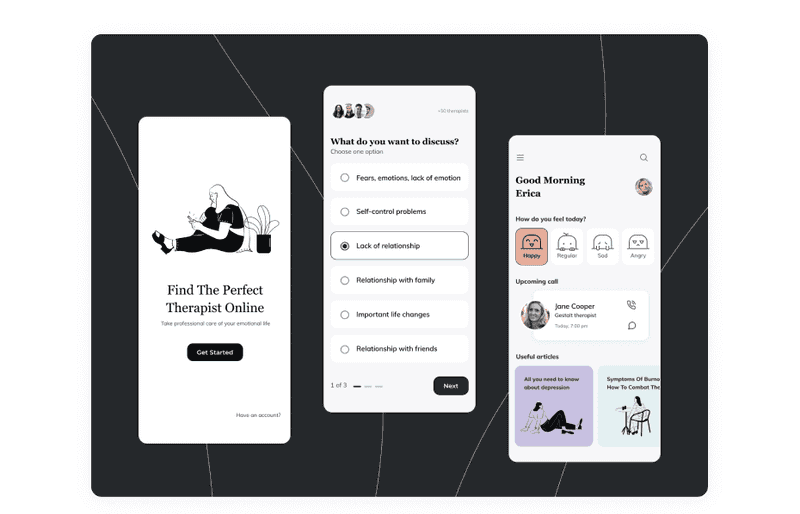
Dribbble shot by Cadabra Studio
-
Truth challenge
Providing accurate and reliable information about mental health conditions and treatments. This can be challenging, as mental health is a complex and nuanced field that requires extensive research and understanding.
-
Marketing challenge
Developing effective marketing strategies to promote the counselling app and reach the target audience. With so many mental health apps available, standing out and attracting users can be difficult.
-
Users’ engagement challenge
Ensuring the counselling app provides a positive user experience that encourages engagement and adherence to therapy. Mental health app developers must balance offering tools and resources while not overwhelming the user.
To sum up, developing a mental health app is both demanding and fulfilling. It requires meticulous attention to every aspect, including the app’s layout, safeguarding measures, promotion tactics, and user satisfaction, to guarantee that it delivers on its promise of enhancing the mental well-being of its users.
Conclusion
Creating a mental health app like BetterHelp requires careful consideration of design, development, marketing, regulatory compliance, and data security. It’s important to keep in mind that the app should be user-friendly, engaging, and able to provide a safe and secure space for therapy.
If you’re interested in creating your own mental health app but don’t know where to start, the team at Axicube can help. With our expertise in app design, we can assist you in developing a unique and innovative app that can make a difference in people’s lives.
Revolutionize mental health with our app development services. Contact us to bring your innovative ideas to life and transform lives by boosting mental well-being. Let’s collaborate!
